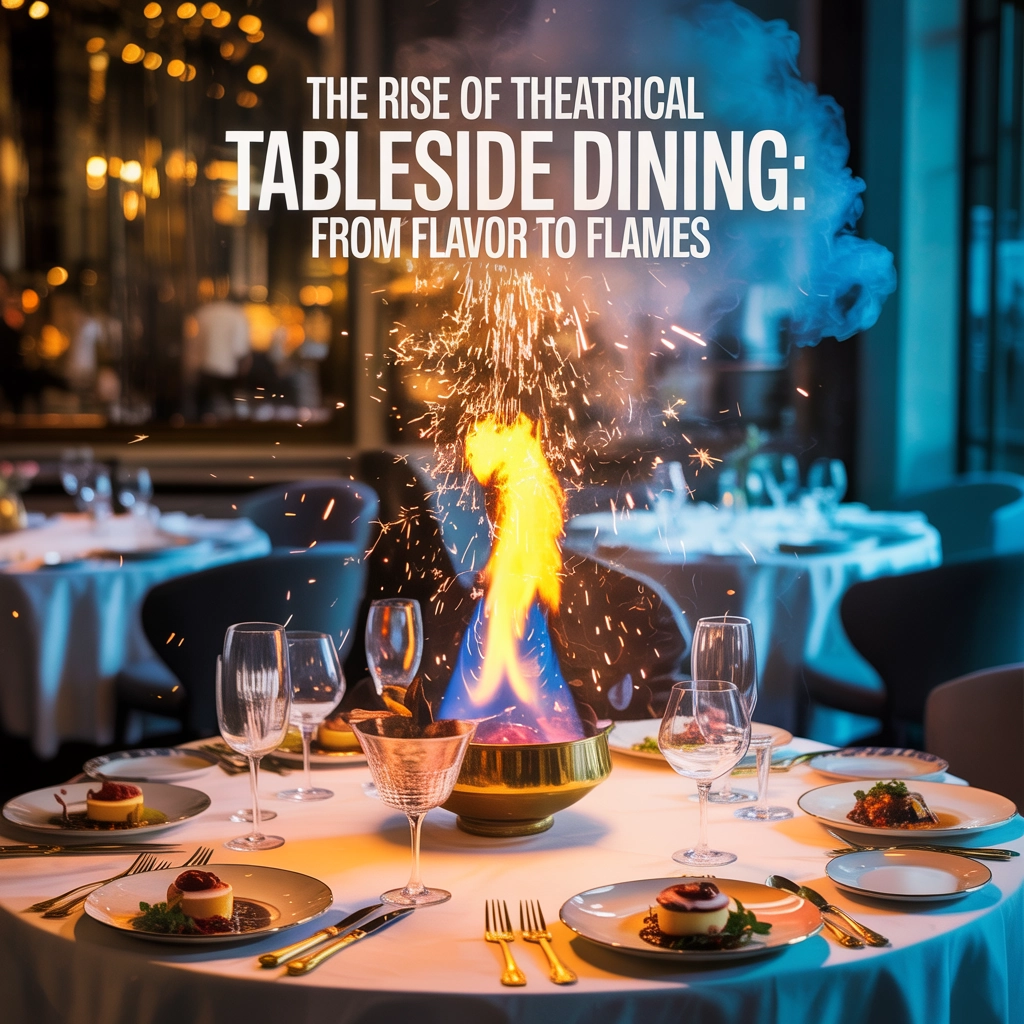In an era dominated by digital experiences and takeout convenience, something remarkably analog is making a dramatic comeback in restaurants nationwide. Theatrical tableside dining—where preparation becomes performance and food transforms into spectacle—has reemerged as one of 2025’s defining culinary trends. From flaming cocktails that dance with blue flames to dramatic carving rituals and sauce preparations executed with surgical precision, restaurants are discovering that dinner and a show can happen simultaneously, at the very same table.
The Evolution of Tableside Theater
Tableside service isn’t new—it has roots in classical French dining traditions, where dishes like Crêpes Suzette were flambéed with theatrical flair beside aristocratic diners. The tableside Caesar salad, Steak Diane, and Bananas Foster all enjoyed their heyday in mid-century fine dining before gradually fading as casual dining concepts and kitchen-focused experiences took center stage.
“What we’re seeing now isn’t simply a revival of old-school continental dining,” explains James Beard-nominated chef Marcus Samuelsson. “It’s a reinvention that combines traditional technique with modern sensibilities and an understanding of what today’s diners truly value—authenticity, craftsmanship, and shareability.”
The new wave of tableside dining marries classical technique with contemporary showmanship, creating moments designed not just for the palate but also for Instagram feeds and TikTok videos. The result? Restaurants are converting routine dining occasions into memorable experiences worth both the premium price and the social share.
Why Theatrical Dining Resonates in 2025
Several factors have converged to make theatrical dining particularly relevant today:
Post-Pandemic Connection Hunger
After years of remote interactions and socially distanced experiences, diners crave meaningful face-to-face moments. Tableside preparation creates natural opportunities for engagement between staff and guests.
“People are looking for more than sustenance when they dine out,” says hospitality consultant Rebecca Chen. “They want connection, surprise, and the feeling that they’re participating in something special. Tableside service delivers all three.”
The Experience Economy
As material possessions lose cultural capital, experiences gain it. Today’s consumers—particularly Millennials and Gen Z—consistently prioritize experiences over objects, and they’re willing to pay premium prices for memorable moments.
Social Currency
In an attention economy where personal content fuels social media engagement, visually spectacular dining experiences provide perfect content fodder. A flaming cocktail or dramatically carved meat generates organic social sharing that traditional advertising simply can’t buy.

Richard Sandoval Hospitality: Masters of Tableside Drama
Leading the charge in this theatrical dining renaissance is Richard Sandoval Hospitality (RSH), whose restaurants have embraced tableside drama as a signature element of their dining experience. With operations spanning multiple concepts across the country, RSH has identified the sweet spot where culinary excellence meets theatrical presentation.
“At RSH, we’ve always believed dining should engage all the senses,” says Richard Sandoval, founder and CEO. “When we prepare something tableside, we’re not just serving food—we’re creating a multi-sensory story that guests remember long after the meal ends.”
Standout RSH tableside experiences include:
Flaming Mexican Coffee
Available at Cayao Cabo and Toro Cabo, this spectacle begins with a carefully choreographed ritual where servers blend premium tequila, rum, or whiskey with warm baking spices and freshly brewed espresso. The mixture is set ablaze tableside, creating dancing blue flames that caramelize the sugars and infuse the drink with complexity while diners watch in amazement.
Flamed Mango Coquito
At Toro Chicago, RSH has reimagined the classic Puerto Rican holiday drink with a tropical twist. The creamy coconut-based beverage features fresh mango and is dramatically flamed tableside, creating an aromatic experience that engages both sight and smell before the first sip.
Mezcal-Flamed Tomahawk Steak
Perhaps the most impressive of RSH’s tableside performances, this presentation features a massive tomahawk steak brought to the table still sizzling. Servers then pour premium mezcal over the meat and ignite it, creating a spectacular flame that imparts smoky, complex notes while diners capture the moment for social sharing.
La Baja Lobster Tail
At Cayao Cabo, servers bring fresh lobster to life with a tableside preparation that highlights the pristine quality of Baja seafood. The presentation emphasizes transparency—allowing guests to see exactly what they’re eating and how it’s prepared—while creating an intimate connection between diner, preparer, and ingredient.

The Psychology Behind the Spectacle
The appeal of theatrical dining runs deeper than mere entertainment. Research from Cornell University’s School of Hotel Administration suggests that visible food preparation triggers several psychological responses that enhance the dining experience:
Perceived Value Enhancement
When diners witness the skill, labor, and premium ingredients that go into their dish, their perception of its value increases significantly. A Cornell study found that visible preparation increased diners’ willingness to pay by up to 30% for identical dishes.
Trust and Transparency
In an age of food skepticism, witnessing preparation builds trust. “Seeing is believing,” explains food psychologist Dr. Amanda Torres. “When diners watch their food being prepared, they feel reassured about quality and safety in a way that menu descriptions alone can’t achieve.”
Anticipation Building
The tableside ritual extends the pleasure of dining by creating an anticipation phase. This pre-consumption period activates reward centers in the brain, effectively extending the enjoyment of the meal beyond just the eating portion.
Implementing Tableside Theater: Challenges and Solutions
For restaurants considering adding theatrical elements to their service, several considerations come into play:
Staff Training
Successful tableside service requires staff who are equal parts chef, server, and performer. Front-of-house teams need training not just in preparation techniques but also in presentation skills and engaging patter.
“It’s a significant investment in training,” admits Victor Albisu, chef-owner of Taco Bamba. “But the ROI is clear when you see how these performances transform the energy of the dining room and drive repeat visits.”
Space and Safety Considerations
Flaming presentations and tableside cooking stations require careful planning for both space allocation and safety. Restaurants must consider ventilation, fire safety protocols, and dining room layout.
Pace and Timing
Perhaps the most challenging aspect is integrating theatrical elements without disrupting service flow. “You can’t have every table experiencing a tableside presentation simultaneously,” notes operations consultant Maria Lopez. “Creating a rhythm that works for both the kitchen and the dining room is crucial.”

The Business Case for Tableside Drama
While the up-front costs of implementing theatrical dining elements may seem substantial, the business benefits can be significant:
Menu Premium
Restaurants successfully implementing tableside service report price premiums of 15-25% for theatrical presentations compared to identical dishes prepared in the kitchen.
Increased Beverage Sales
The extended dining experience created by tableside presentations correlates with higher per-table beverage sales. RSH reports a 22% increase in wine bottle (versus glass) orders at tables experiencing multiple tableside presentations.
Word-of-Mouth Marketing Value
The organic marketing generated through social sharing of theatrical dining moments represents value that would cost thousands in traditional advertising. A single viral video of a tableside presentation can generate hundreds of thousands of impressions.
Staff Retention
Interestingly, restaurants with theatrical elements report improved staff retention. “Our servers earn more through higher check averages, but they also report greater job satisfaction,” says Sandoval. “There’s pride in mastering these presentations and joy in creating memorable moments.”
The Future of Theatrical Dining
Where is tableside theater headed? Industry experts predict several evolutions:
Technology Integration
Some forward-thinking restaurants are already experimenting with augmented reality elements that enhance tableside presentations, projecting information about ingredients or adding visual effects to physical performances.
Customization Elements
The next frontier may be personalized tableside preparations, where diners participate in customizing their experience by selecting components or influencing the preparation style.
Cross-Cultural Fusion
As global culinary influences continue to blend, expect to see traditional tableside preparations from various cultures reimagined with contemporary twists.
Conclusion: From Sustenance to Spectacle
In a dining landscape where differentiation is increasingly difficult, theatrical tableside service offers restaurants a powerful way to create memorable experiences that resonate with today’s experience-hungry consumers. For operators willing to invest in training, equipment, and choreography, the rewards include premium pricing, increased social visibility, and the creation of signature moments that drive loyalty and word-of-mouth.
For diners, the reward is richer still—a multi-sensory journey that transforms eating from mere sustenance into spectacle, creating memories that linger long after the last bite is savored and the final flame extinguished.
Are you incorporating theatrical elements in your restaurant’s service? Share your experiences in the comments below or contact us to feature your innovative approach in an upcoming issue of Food & Beverage Magazine.
Written by Michael Politz, Author of Guide to Restaurant Success: The Proven Process for Starting Any Restaurant Business From Scratch to Success (ISBN: 978-1-119-66896-1), Founder of Food & Beverage Magazine, the leading online magazine and resource in the industry. Designer of the Bluetooth logo and recognized in Entrepreneur Magazine’s “Top 40 Under 40” for founding American Wholesale Floral. Politz is also the founder of the Proof Awards and the CPG Awards and a partner in numerous consumer brands across the food and beverage sector.






